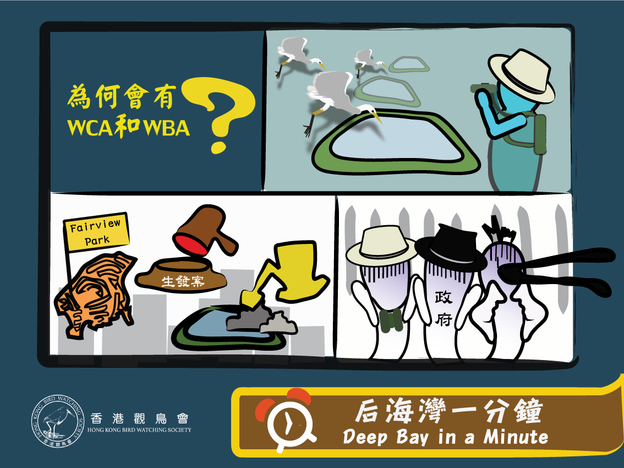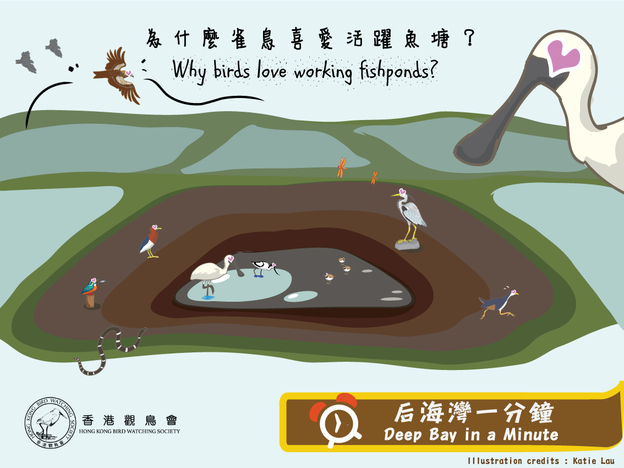【后海灣一分鐘】一、 甚麼是濕地保育區(WCA) 和濕地緩衝區 (WBA)?


后海灣濕地及泥灘是各種水鳥及冬候鳥的重要覓食地及棲息地。七八十年代期間,米埔沼澤區逐漸獲得香港法例的保護,並邀請世界自然基金會積極管理該區的生境。但直至1997年「后海灣地區魚塘生態價值研究」完成後,政府才正式確認魚塘具有重要的生態價值。事實上,魚塘與米埔沼澤區在生態上具有緊密的關連,是后海灣濕地生態系統的一部分。因此,我們應同時保育后海灣相連的濕地及魚塘,包括豐樂圍、南生圍、甩洲、新田、馬草壟等地區,以維持其生態完整性。
隨著后海灣一帶的發展壓力增加,城市規劃委員會(城規會)為后海灣制訂規劃指引(規劃指引編號12),並成立「濕地保育區」(Wetland Conservation Area)及「濕地緩衝區」(Wetland Buffer Area),以規管在后海灣地區的土地使用和開發。
濕地保育區旨在保護由大小不一但相連的魚塘所組成的核心區域,而濕地緩衝區則是以保護濕地保育區為目標的緩衝區。 在濕地保育區內,除非是保育該區的生態環境,或具有絕對壓倒性的公眾利益而必須進行的基礎設施項目外,不容許任何新發展。濕地緩衝區則在不損害濕地保育區魚塘生態價值的前提下,或許容許一些住宅或康樂發展,以移除現有的開放式存儲用途和恢復一些被破壞的魚塘。
本會認為任何發展項目都必須嚴格遵守濕地保育區/濕地緩衝區的規劃管制,以保護后海灣濕地生態系統的生態完整性。
【Deep Bay in a Minute】1. What is WCA and WBA?
The Deep Bay wetlands and mudflats is a globally recognized foraging and roosting ground for waterbirds and other migrant winter birds. The Mai Po marshes were gradually protected under Hong Kong legislation and actively managed during the 1970s and 80s. Yet, it was not until the Study on the Ecological Value of Fishponds in the Deep Bay Area completed in 1997 that formally recognized the ecological value of fishponds. In fact, the fishponds are ecologically connected to the Mai Po Marshes and form an integral part of the Deep Bay wetland ecosystem. Therefore, the continuous and adjoining wetlands and fishponds in the Deep Bay, including such areas as San Tin, Nam Sang Wai, Lut Chau and Hoo Hook Wai should be conserved in order to maintain its ecological integrity.
As the development pressure increased, the Town Planning Board established the “Wetland Conservation Area” (WCA) and “Wetland Buffer Area” (WBA) to regulate applications for different land use and development in the Deep Bay Area. Under the Town Planning Board Guideline No 12 the WCA was designated to conserve the core area which consists of continuous and adjoining fishponds, while WBA was designated as a buffer zone to protect the WCA. No new development is allowed within the WCA unless it supports nature conservation in the area or is an essential infrastructure with overriding public interest. Residential or recreational development in the WBA, which helps to remove the existing open storage use and/or to restore some of the fishponds and would not have adverse ecological impacts on the WCA may be allowed.
Besides the WCA and WBA, the “precautionary approach”, which states that you should not take an action without being aware of the outcome, and the principle of “no-net-loss in wetland” are also important concepts adopted in Guideline 12.
HKBWS considers that the above planning controls and principles should be strictly followed in order to conserve the ecological integrity of the Deep Bay wetland ecosystem.
【后海灣一分鐘】二、「濕地保育區」(WCA) 和「濕地緩衝區」(WBA) 從何而來?


六十年代起,地產發展開始擴散至新界以至后海灣一帶的濕地,包括其後出現鄰近米埔的錦綉花園私人住宅項目和天水圍新市鎮。1983年的「生發案」中,高級法院裁定只要發展不包括任何建築物,地段擁有人可以把土地用作農業以外的用途,於是進一步鼓勵更多魚塘被填平作各類棕地作業,嚴重威脅后海灣的濕地生態。
隨著港英政府估計鄉郊土地將受到無法預期的破壞,環境保護署於1988年委託顧問公司,研究后海灣地區的自然資源和潛在的環境問題,制訂行動計劃以管理后海灣,並評估不同發展項目以致整體的發展模式帶來的累積影響。報告確認了后海灣濕地的重要性並提出多項保育建議,例如訂立綜合環境管理計劃,並為后海灣設立緩衝區。
1991年,《城市規劃條例》正式加入鄉郊地區的發展管制。規劃署於1992年制訂指引,以管制在后海灣經城市規劃委員會審批的發展規劃,並成立后海灣緩衝區一(BZ1)和二(BZ2)。
米埔內后海灣一帶於1995年正式被納入為「拉姆薩爾濕地」,規劃署於同年委託顧問公司進行「后海灣地區魚塘生態價值研究」,確認魚塘的生態價值。報告建議將連綿一片的魚塘劃為濕地保育區作保育,並將保育區以外的五百米範圍劃為濕地緩衝區。濕地保育區及濕地緩衝區於1999年正式取代BZ1和BZ2,其範圍在2014年隨邊境禁區開放而延伸至蠔殼圍及馬草壟一帶。
2004年,「內后海灣及深圳河集水區」亦被國際鳥盟認可為「重點鳥區」,範圍由白泥及流浮山伸展至塱原等地,包括大部份濕地保育區及濕地緩衝區。
【Deep Bay in a Minute】2. Where did WCA and WBA come from?
Since the 1960s, development pressure started to encroach into the Deep Bay area, with new developments such as Fairview Park and Tin Shui Wai New Town emerging in the 1980s and 1990s. The “Melhado” case in 1983, in which the High Court ruled that land zoned for agriculture may be used for non-agricultural purposes as long as no structure is built, has led to the draining of fishponds for brownfield operations such as container storage that threatened the wetlands in the Deep Bay area.
In 1988, the Environmental Protection Department commissioned a consultant to study the impacts of development activities on the environmental and natural resources of Deep Bay and to develop an action plan for the management of the Deep Bay. The study recognized the importance of the Deep Bay wetlands and recommended conservation actions including the establishment of integrated conservation management plans and buffer zones for Deep Bay.
In 1991, development control in rural areas was introduced under the Town Planning Ordinance (TPO). In 1992, the Planning Department established a set of planning guidelines under the TPO to regulate development applications in the Deep Bay area with Buffer Zones 1 (BZ1) and 2 (BZ2).
In 1995 Mai Po and Inner Deep Bay was recognized as wetland of International Importance under the Ramsar Convention. In the same year the Planning Department commissioned a study on the Ecological Value of Fish Ponds in the Deep Bay Area, which confirmed the ecological importance of fishponds. The study recommended that the continuous and adjoining fishponds should be conserved and to be zoned as “Wetland Conservation Area” (WCA), while a surrounding buffer zone of about 500m wide to be designated as “Wetland Buffer Area” (WBA). In 1999, the BZ1 and BZ2 were replaced by WCA and WBA and was extended to cover the Hoo Hok Wai and Ma Tso Lung area in 2014 after the opening of the frontier closed area.
In 2004, the Inner Deep Bay and Shenzhen River catchment area, including areas of WCA/WBA and other areas stretching from Pak Nai and Lau Fau Shan to Long Valley, was recognized by Birdlife International an Important Bird Area.
【后海灣一分鐘】三、為什麼雀鳥喜愛活躍魚塘?


魚塘的生態價值其實與魚塘的運作息息相關。漁民在收獲塘魚(俗稱「刮魚」)前會先把塘水泵到鄰近的魚塘,這些淺水魚塘吸引候鳥前來捕捉一些經濟價值較低的雜魚和無脊椎動物。我們在這些淺水的魚塘濕地共錄得83種水鳥及依賴濕地的雀鳥,當中更有11種為全球瀕危鳥種,如極度瀕危的勺嘴鷸和瀕危的黑臉琵鷺。降水後的魚塘所錄得的水鳥物種比降水前高出達19倍。
自2012年起,香港觀鳥會獲環境及自然保育基金資助,在新界西北的魚塘展開自然保育管理協議計劃,以確保魚塘每年都會降低水位,並維持該水位至少一個星期。這正正就是「明智使用濕地」的最佳例子,透過與本地漁民合作保育濕地,同時有利經濟和社會方面得以永續。每年參與計劃的養魚戶管理后海灣一帶超過600公頃的魚塘。
但由於魚塘降水主要由市場主導,每一次降水的魚塘只佔后海灣整片魚塘的一少部份,所以供給雀鳥的食物會隨時間和空間而有所改變。我們應保護及維持大量的魚塘運作,以確保每一刻都有魚塘進行降水,為雀鳥提供穩定的食物供應。
【Deep Bay in a Minute】 3. Why birds love working fishponds?
Interestingly, the ecological value of fishponds is related to its operation. When fishermen drain the ponds to harvest their fish, the trash fish (those that are too small to be sold) and other invertebrates left in the shallow water of the pond creates a favourable feeding habitat for waterbirds. 83 waterbirds and other wetland-dependent bird species were recorded utilizing drained fishponds, including 11 globally threatened species. These include the critically endangered Spoon-billed Sandpiper and the endangered Black-faced Spoonbill. The number of waterbird species recorded during drain-down was found to be about 19 times higher than the number recorded before the fishpond drain-down.
In 2012 HKBWS established a Management Agreement with a number of fishpond operators in Deep Bay with funding support from the Environment and Conservation Fund, under which each fishpond must be drained for at least a week per year. This is an example of “wise use of wetland”, where conservation of wetland is achieved through the engagement of the local fishpond operators, as it is both economically and socially sustainable, as well as beneficial for the environment. Every year, fishpond operators participated in the scheme are managing over 600 hectares of fishponds in the Deep Bay area.
However, as the drain down is market driven, the number of drained fishponds at any one time only represent a small percentage of the total, and thus the food supply for birds at fishponds changes over both time and space. Therefore, it is important to conserve a large number of fishponds, so as to ensure there are drained fishponds at any given time in order to maintain the food supply for birds.
[
Last edited by HKBWS Suet Mei at 22/02/2019 17:40 ]


